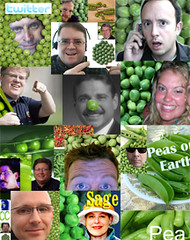
An interesting, spontaneous, and live debate occurred between
Shel Israel, co-author of Naked Conversations, and
Scott Monty, a new media communications executive at Ford Motor Company, on Twitter, the popular real-time short messaging service, today.
The discussion began shortly after Israel pointed to a New York Times
article. It provides an engaging look at real-time social media in action.
Here is a portion of it, minus background noise and side discussions.Monty: Shel, the issue is a little more complex than you're making it.
Israel: Issues are always complicated until a solution simply emerges.
Monty: A single, nationalized standard is what's needed, not state-specific standards.
Israel: Ca welcomes other states to join our standard. The Ca standards 1st offered 12 yrs ago. What progress has Detroit made towae=rd compliance during that time? During that time what has Detroit spent to block or delay the standards during that time?
Monty: The entire auto industry - not just *Detroit* - is behind a single, national standard. You should familiarize yourself with what Ford is already doing (and plans to do) to meet fuel econ & emissions standards.
Israel: So then, you should have no problem with selling Fords everywhere that comply with the new Calif, emissions standard, right? Now ask that question of your customers.
Monty: This is just me speaking (not Ford): I think a single, high standard would be preferable to multiple standards. We're raising the fuel economy standard across every single vehicle we make - to best-in-class or among best-in-class.
Israel: How much $$ was spent by Detroit to oppose tougher emission standards. What would have happened if you had invested in R&D.
Monty: It's not just R&D Shel. It's the associated $ to retool entire plants.
Israel: You know, I've been sympathetic to Detroit, but if given a choice between sustaining Earth & Sustaining Ford Motors--sayonara.
Monty: Just goes to show me that you know next to nothing about our sustainability efforts. You should research before you tweet. (To others: Please check out some of our efforts in the green area. There's lots here
http://bit.ly/1KtP73)
Israel: Golly, Scott. You don't sound like that when I take Ford's side. Why is it that I'm considered knowledgeable then & stupid now?
Monty: Because you did your research then.
Israel: My position requires little research Calif chooses strict emission standards. Ford can choose to comply or not. I do not argue that Ford is working on sustainability. But you are unwise to say that the Feds should prevent CAlif. standards.
Monty: I don't think the CA should be denied (again, Scott talking). If we use that as the single standard, great. Not multiple states
Israel: When Calif acted out of frustration, Detroit went to DC to stop us. There's been a recent change in policy.
Monty: If CA wants to spend its money to fight global warming, good luck. There are other important priorities at stake in the economy.
Israel (hours later): [Scott Monty] wants to point out the good efforts Ford has made and in fact, I believe that's true. But Detroit doesn't get to set the pace.
Monty: You're absolutely right. There's a new pace being set - but at the same time we need to operate within what's realistic now.
Israel: With all due respect, that's precisely what Detroit said to CA in 1997, when hearing were held in this state. CA is throwing down a Green Gauntlet. It's an easier challenge than Kennedy saying man would walk on the moon in 8 yrs. It's time to take the issue seriously for the sake of your kids & my grand children.
Monty: With all due respect, Shel - when did you become an automotive analyst? We've got no problem taking it seriously. We're moving faster than you know. ... But real business decisions need to be made for today as well as for tomorrow. It's a balance.
Israel (hours later): With all due respect, no expert on automotive but I do see an entrepreneurial opportunity when I see one. I'll be happy with any company that complies w/standards. I'll be at the Ford showroom the day you meet that standard. I'll even tweet your virtues.
What wasn't communicated that could have added value to the conversation?California took the lead in setting the strictest auto emissions because it began taking steps to regulate emissions well before federal standards were set. In fact, California has been at this much longer than Israel gives the state credit. The California Legislature passed the Mulford-Carrell Act, which combined two Department of Health bureaus — the Bureau of Air Sanitation and the Motor Vehicle Pollution Control Board — to establish the Air Resources Board (ARB) in 1967. The ARB wasn't even California's first emission reduction effort.
However, California is also the leading polluter in the United States. In 2008, the American Lung Association's 2008
State of Air Report, California metropolitan areas account for five of the top ten most long-term particle polluted metros (with seven cities received a failing grade) and five of the top ten most ozone polluted metros (with twelve cities receiving a failing grade) in the U.S. The cause isn't automotive as much as it is lifestyle.
Of course, much like California, the automotive industry has a mixed record on environmental issues too. You can find an extensive, and reasonably brand neutral, account of the automobile and the environment by Martin V. Melosi right
here. It doesn't take an automotive industry expert to deduce that fuel prices more than any other factor dictate what consumers will purchase.
When gas prices are high, like they were in the 1970s, consumers buy fuel-efficient cars. When gas prices are low, they buy SUVs. The American automotive industry tends to compete better in the latter market, although Ford does have 13 U.S. models that achieve 30 miles per gallon or better. The Ford Focus was named one of the top ten greenest cars in 2008.
The American automotive industry has made significant contributions in the development of green vehicles, sometimes at the expense of their own viability (and sometimes for the benefit of competitors). And sure, they've made mistakes too. But blaming the automotive industry for attempting one of the trickiest balancing acts in history seems disingenuous.
You see, I drove one of the earliest electric cars in the 1990s. The public didn't want them. The infrastructure wasn't in place to support them. They were creepy quiet to drive. And, while researching them, nobody could tell me what they planned to do with all the spent batteries. In fact, almost 20 years later, there is no real indication that any of this has changed en masse.
The bottom line is that we need solutions. However, considering we
all contribute to the problem every day, those solutions will only come from shared accountability and consensus building. We need discussion over diatribe, the kind that has helped us realize substantial reductions since the 1960s.
Do real-time online conversations add value to communication or cause confusion?It depends on the conversation and the participants. This one today, despite praise from observers, doesn't add much value.
To his credit, Monty delivered more communication than non-communication during the discussion, better than 2-to-1. In comparison, Israel delivered more non-communication than communication, almost 3-to-1. But this wasn't a boxing match.
Nobody wins, especially those who were listening.
Even with what little truth was alluded to, it's difficult to walk away with a real appreciation of this complex issue beyond polarized content. Simply put, Twitter was not a suitable platform for this discussion. Beyond that, maybe you can tell me.































